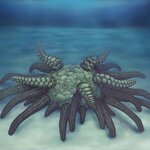Ecology & Zoology

There is one Cthulhu it's safe to invoke; Sollasina cthulhu, obviously named after H.P. Lovecraft's tentacled monster, a 430 million-year-old fossil that has been identified as a new species related to living sea cucumbers.
The new cthulhu, Sollasina, was an echinoderm (the group that includes sea urchins, sea cucumbers, and sea stars) that had 45 tentacle-like tube feet, which it used to crawl along the ocean floor and capture food. The creature was small, about the size of a large spider. It was found in the Herefordshire Lagerstätte in the United Kingdom, a site that has proven to be a…

Canine leishmaniosis is a potentially fatal infection caused by the parasite Leishmania infantum, carried by the female sand fly and transmitted in its bite. It is zoonotic, so can be passed on to people but dogs have been known to pick up the infection after being bitten or wounded by another infected dog.
That's rare, and in the UK cases to-date have only been associated with blood transfusion, breeding programs, or overseas travel but a 3 year old neutered male shih tzu cross, which had been with its owner since a puppy and had none of the known risk factors for infection, was…

Everyone in 2019 likes to claim their beliefs are grounded in evidence. The most anti-science groups, from the journalism department at
New York University Arthur L. Carter Journalism Institute
to Greenpeace, still claim to have evidence-based decision-making behind their political or financial agendas. It's no different in the "raw" pet food market, but it's harmless posturing to wrap yourself in the veil of science unless you are actually claiming to be scientific when you poison people or their pets.
Then it's not just harmless marketing, like when dog food commercials trot out…

Semen stored in a laboratory in Sydney has been defrosted and successfully used to impregnate 34 Merino ewes, with the resulting live birth rate as high sperm frozen for just 12 months.
The authors believe the sperm used is the oldest viable stored semen of any species in the world and definitely the oldest sperm used to produce offspring. The original semen samples were donated from sires owned by the Walker family. Those samples, frozen in 1968 by Dr Steven Salamon, came from four rams, including 'Sir Freddie' born in 1963, owned by the Walkers on their then property at Ledgworth. The…

Megachile pluto, Wallace's giant bee, is the world's largest, with a wingspan more than 2.5 inches. Though it should be easy enough to see, some had believed it was extinct because it hadn't been seen by western scientists since 1981.
In January, a search team set out to photograph Wallace's giant bee and successfully did so, declaring in a documentary they have "rediscovered" the species in the North Moluccas, an island group in Indonesia.
The bee is named after Alfred Russel Wallace, the co-discoverer alongside Charles Darwin of the theory of evolution through natural selection. Wallace,…

Ribbon worm? Arrow worm? Since the discovery of its fossil over a century ago, paleontologists have speculated about what branch of evolution Amiskwia sagittiformis was on.
Charles Doolittle Walcott, who first described it, compared it to the a group of ocean-dwelling worms that are fierce predators, equipped with an array of spines on their head for grasping small prey - modern arrow worms (chaetognaths), but later scientists could not find evidence of the canonical grasping spines so they believed instead it might be a a ribbon worm, or its own distinct lineage only distantly related to…

Limenitus archippus, the viceroy butterfly is a mimic, modeling its orange-and-black colors after the queen butterfly, a bug that tastes so disgusting predators have learned not to eat it or anything that looks like it, including viceroys.
The apparent dependence of mimics on their models made biologists wonder if the fates of the two species are forever intertwined. If so, then what happens when the mimic and the model part ways? Thanks to a new study, scientists know. Viceroy butterflies living in northern Florida, far away from the southern-dwelling queen butterflies, are not only more…

Please don’t be scared by this, it is just the journalists hyping things up again. It does not mean what it seems to mean from the headlines. Insects can’t vanish and we will continue to be able to grow our crops and do agriculture. The study itself involves a lot of extrapolation on inadequate data, not their fault, it is just that there hasn’t been that much research done on insect populations for them to draw on.
The number of studies they found, 73, is not a lot for the whole world and the studies are limited. The authors are also getting criticism on twitter by experts for the way they…

Let’s be honest – environment news isn’t always the jolliest, and 2018 was no exception. From climate change, to recycling, to energy policy, at times it has felt like we’ve been lurching from one crisis to the next.
So here are ten upbeat environmental stories from this year that prove it’s not all doom and gloom.
Cane toads cracked
In September, scientists announced they have decoded the cane toad genome, potentially paving the way for new weapons to repel the slimy invaders.
The successful effort potentially makes it easier to identify viruses that can be used to attack the toxic toads…

Wind turbines are a leading source of green energy which could supply 12% of the world’s energy by 2020. But their use is often criticised for its impact on wildlife, particularly birds. Larger birds can collide with turbines and some have even learned to avoid flying near them.
Impacts on smaller birds are less well documented as they tend to maneuver around turbines and can avoid impacting with them much more easily than larger species. My own research showed that birds associated with farmland, including a range of songbirds, were generally unfazed – their winter distribution didn’t change…